What is Lease Management (and Why Does it Matter)?
What is Lease Management (and Why Does it Matter)?
Lease management is how organizations carry out a wide range of tasks related to their leases.
When a company needs to make decisions about where to renew, relocate or remodel their locations, ensure they are accounting for their leases according to the most recent standards, or keep up with certain terms and clauses so they aren’t being overcharged, the lease management team is called to action.
What You’ll Learn:
- What to look and prepare for when negotiating your lease
- What goes into the day-to-day of lease management and lease accounting
- The current compliance standards
- The reports every lease administrator needs
- Why lease management software is key to making it all work efficiently
Lease management is vital for your organization to get right because real estate is your #2 expense and missed opportunities can cost you a lot of time and money.
Lease Management: Negotiating the Early Terms
Lease Management starts with negotiating the right lease for you. From the beginning, you’ll want to create a lease that works for your organization in the short and long term.
Some of the essential aspects to negotiate include:
Co-tenancy Clauses
Co-tenancy clauses offer tenants an opportunity for rent relief or other relief options if certain tenants leave a location or occupancy drops below a certain level. It’s an important clause to negotiate upfront because part of the reason you chose the location you did was because you knew what tenants you wanted near you to help drive the right customers to your location. You don’t want to be negatively affected if those tenants leave the location, so you need to add a co-tenancy clause in your lease from the start.
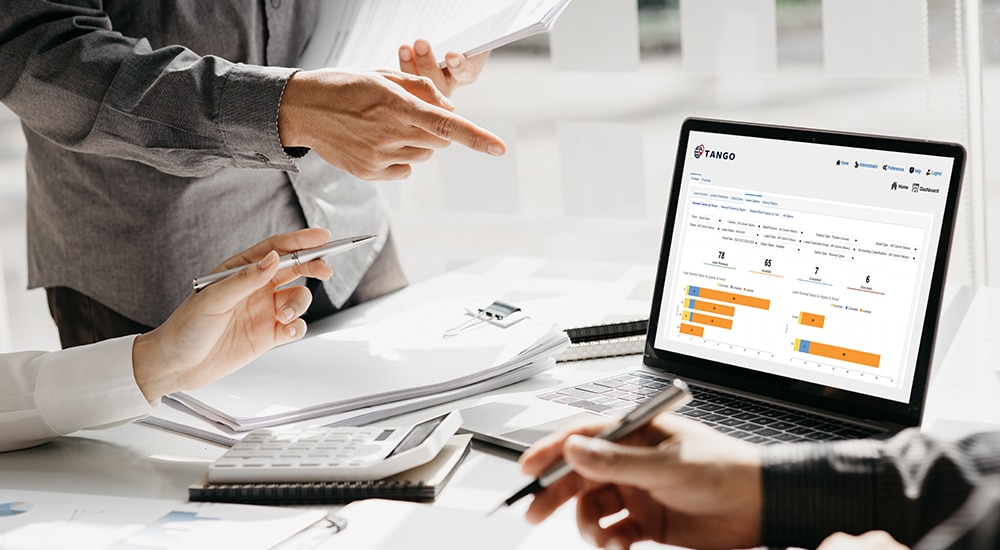
Lease Incentives
Lease incentives are benefits added to encourage tenants to enter into lease agreements. If landlords are especially motivated to get you to sign a lease with them, they may be willing to change terms and accommodate your needs and desires. But if you don’t know what to bring to negotiations, you may miss out on some significant incentives.
Some lease incentives you should bring up in negotiations include:
- Reimbursement for fees incurred from breaking a pre-existing lease commitment.
- Relocation costs related to moving from one property to another.
- Rent-free or reduced-rent periods. Landlords will negotiate rent periods of free or reduced rates in order to negotiate a new lease. When this is done, make sure you remember to account for it correctly. Although deferred rent is now obsolete in accounting due to ASC 842, it is still an important part of your expenses.
- Purchase of leasehold improvements. Leasehold improvements are modifications to the interior of a leased building to make it more useful or desirable to the tenant. These can be made to attract tenants, or as a lease incentive during negotiations or during the course of a lease. These can include:
- Tenant improvement allowances
- Build-out allowances
- Rent discounts
- Turnkey projects
- Upfront payment of cash.

Common Area Maintenance
Common area maintenance (CAM) is what tenants pay a landlord to maintain shared spaces, such as lobbies, parking areas, landscaping, cafeterias, and restrooms. It’s valuable to understand and negotiate the ideal CAM terms that go into your lease, so you pay the right amount for the right things. A few terms to consider negotiating include:
- Pro rata share. This is the amount you are charged for the square footage you are leasing. Make sure you understand how the space is being measured, and look out for any mention of your share increasing if other tenants move out.
- Capital costs. This includes repair/activity costs that your landlord may charge all tenants. You can either negotiate terms in your lease to ensure you only pay for certain capital costs or, over the duration of your lease, make sure to monitor these capital costs as they pass through.
- Exclusions. This is your chance to negotiate certain exclusions, such as initial land costs, refinancing costs, costs incurred for specific tenants, interest or penalties incurred by the landlord, and so on.
- Caps. This means negotiating a cap on the amount you will pay for certain items within CAM or for the entire CAM expense. This limits the amount by which your share of CAM costs can increase above the initial charge.
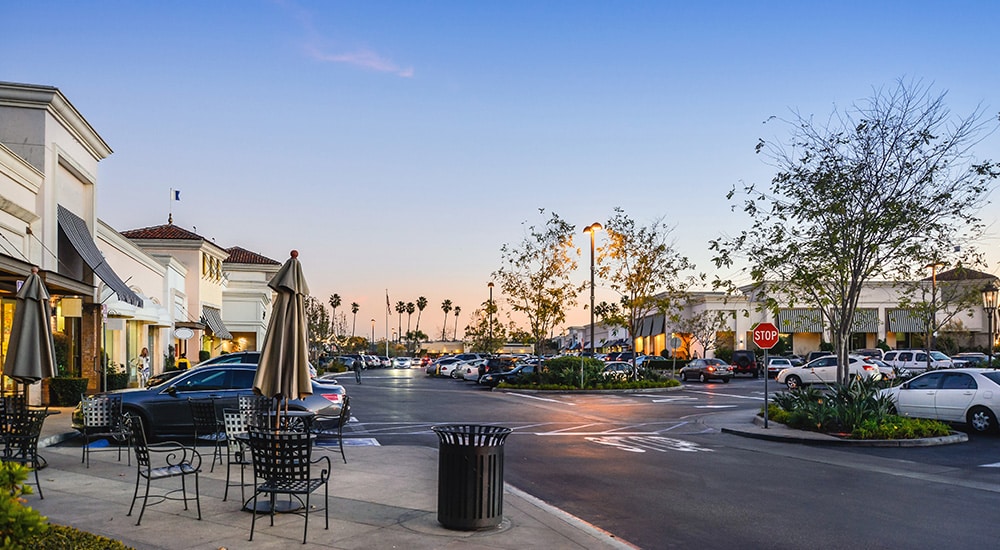
And don’t forget to work through your CAM reconciliations at the end of your lease year. CAM reconciliation is the process tenants use to evaluate whether the amount a tenant paid in CAM charges was correct. You certainly don’t want to be overcharged and not realize it in time.
These are just a few of the common things you should negotiate when going into your lease for a new location. Next, let’s talk about the day-to-day tasks of lease management.
Day-to-Day Administration in Lease Management
Once you’ve negotiated your lease and signed onto your new location, it’s important to create a lease abstract, a concise summary and analysis of your lease agreement, so that employees can quickly get to the most pertinent information without needing to hunt through documents.
Then, it’s time to focus on the monthly tasks that keep your company from falling into hidden occupancy costs, like:
- Consumer price index. Part of lease management includes calculating how the consumer price index (CPI) impacts the recurring costs associated with each lease, including anything you owe retroactively.
- Subleases. These require regular time and attention and can negatively impact your business by hundreds of thousands if not managed properly.
- Additional charges. Any charges received by your landlord, whether it’s for CAM or other operating expenses, means your lease administrator has to compare that bill with the line items in your lease to ensure you aren’t being overcharged.
- Percent rent. Percent rent, rent that a commercial tenant pays based on a percentage of their gross sales, is also quite a time suck requiring 30 minutes of your admins’ time per location every month.
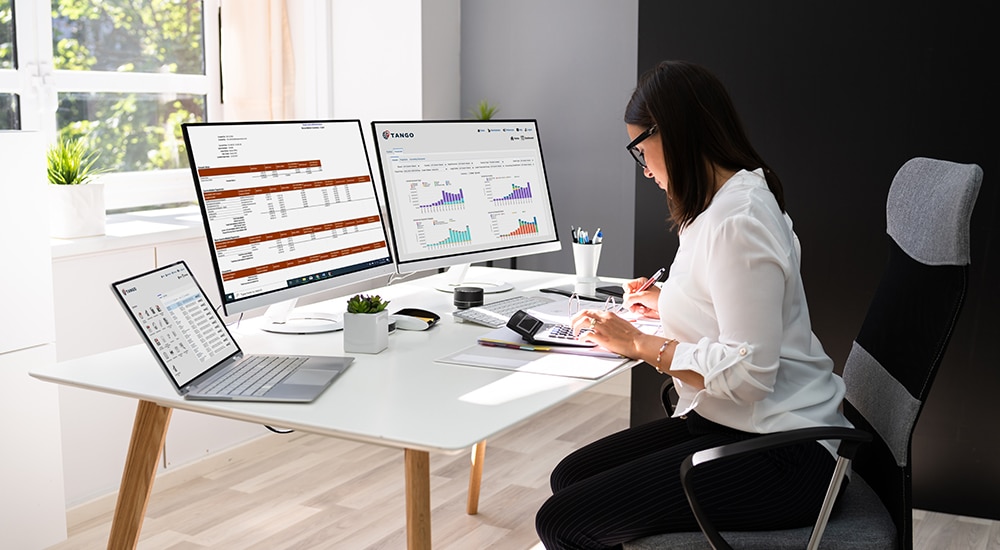
And then you’ve got your lease renewals, too. When a location’s lease renewal comes back up, you can use that time to either find a better location or begin the negotiating process again and see if you can come to better terms for yourself going forward.
We’ve only mentioned a few key lease management tasks that keep your lease administrators busy. Many of which could be automated, saving your company time and money. But we will get into that shortly.
Lease Accounting & Compliance
Lease accounting is the other half of lease management, and it’s a doozy. With the FASB ASC 842, IFRS 16, and GASB 87 standards, companies have to be proactive and on top of all lease compliance requirements.
FASB ASC 842, IFRS 16, and GASB 87
- ASC 842 is a leasing standard issued by the Financial Accounting Standards Board (FASB) that went into effect for public companies on January 1, 2019, and private companies on December 15, 2021. ASC 842 increases disclosure and visibility, where previously most leases were not included on the balance sheet. Now, companies are required to report right-of-use (ROU) assets and liabilities for almost all leases.
- IFRS 16 is a leasing standard issued by the International Accounting Standards Board (IASB) that went into effect on January 1, 2019. IFRS 16 changes the way companies account for leases in their financial disclosures, including balance sheets and income statements. With IFRS 16, all leases are considered finance leases.
- GASB 87 is a leasing standard issued by the Governmental Accounting Standards Board (GASB) that went into effect for public companies on June 15, 2021. GASB 87 increases visibility into lease obligations and removes ambiguity around lease obligations in financial disclosures, particularly balance sheets and income statements.
Lease Accounting 101
To help with meeting these lease accounting standards, there are some vital parts of lease accounting you need to understand. Starting with lease classifications and types:
Two Main Lease Classifications
- Operating leases mean the lessor retains ownership and bears most of the risk. Before ASC 842, these leases were referred to as “off-balance sheet financing,” but now, all leases must be reported on your balance sheet unless it is a lease lasting 12 months or less.
- Finance leases involve the transfer of risk and benefit to the lessee, often with an option to transfer ownership as well. Prior to ASC 842, this type of lease was classified as a “capital lease.”
Next, you have to identify the type of lease that’s related to the type of asset and the manner in which payments are made.
Three Types of Leases
- Real estate leases involve either leasing land or a building and represent the most significant liabilities in an organization’s lease portfolio and one of the largest operating expenses.
- Equipment leases ownership rests in the hands of the lessor while the lessee uses the equipment for the amount of time allotted in the lease.
- Equipment can vary anywhere from airplanes, forklifts, and trucks to soda machines, copiers, or anything else a business may need to operate.
- Embedded leases are components within a contract for other goods or services, which includes the use and control of a related asset. They can be hard to identify because it may appear that a company is not paying for a piece of equipment but they are paying ongoing costs associated with its use.
- To help you spot these, keep in mind the four criteria for identifying whether it’s a lease, and remember, if not all four are met, it does not qualify as a lease:
- It identifies a specific asset
- It gives you the exclusive right to control or benefit from an asset
- It lasts for a known period of time
- It specifies an exchange of consideration
- To help you spot these, keep in mind the four criteria for identifying whether it’s a lease, and remember, if not all four are met, it does not qualify as a lease:
It is more important now than ever to make sure you identify every lease you have. Download and take this decision tree with you to help you find and identify the trickier ones:
Lease Management Reporting
Lease management also requires quite a bit of reporting. Throughout your organization, various departments and roles have different lease-related needs.
Your lease administration, analysts, accountants, real estate directors, and senior leadership don’t use the same data, and their responsibilities are nothing alike. But they depend on the same sources of information: your leases themselves and their associated documents.
Each department needs different lease management reports for different things:
- Lease administrators need to be able to retrieve, organize, and manage essential lease information.
- Lease analysts need to ensure payments are processed on time and accurately.
- Real estate executives need to make informed decisions about locations and leverage intel for negotiations.
- Lease accountants need to prepare budgets and forecasts and create and record reports.

With the right lease management software and advanced reporting capabilities, everyone has access to the reports and documents they need.
Like a lease abstraction report that contains lease information, including all dates, costs, clauses, contacts, options, responsibilities, documents, insurance information, and more.
Or a reconciliation summary that shows lease-specific reconciliation charges displayed year over year so you can compare historical CAM charges, audit potential overcharges, and recognize trends.
And even an accounting schedule detail report that automatically generates lease-specific accounting schedules according to FASB 842 and IFRS standards for operating and finance leases.
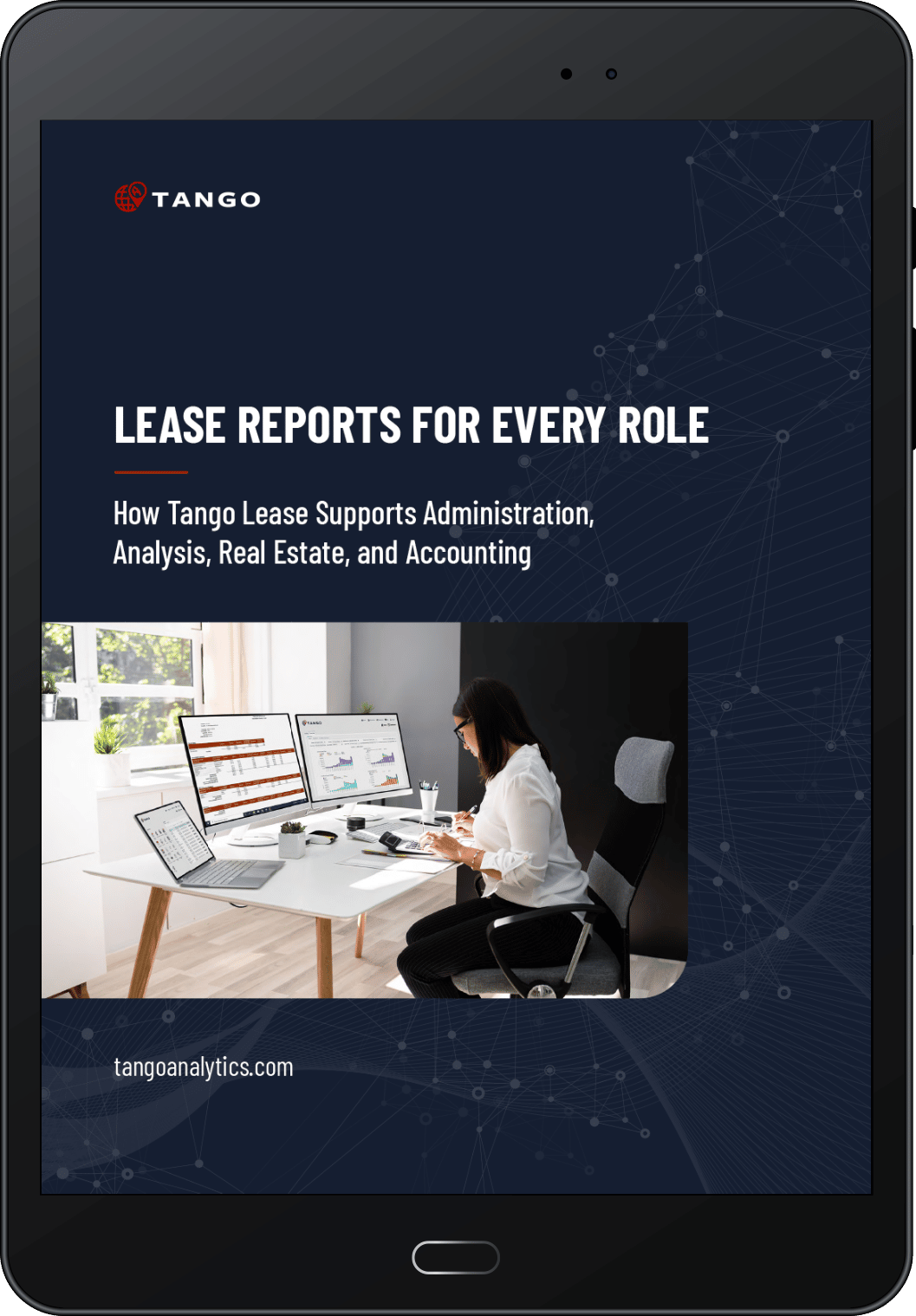
Download the Lease Reports for Every Role eBook
Why You Need a Lease Management Software & How to Pick the Right One
Everything mentioned above is essential to efficient lease management. And that can be overwhelming. It’s a lot to keep up with and can be costly if not done well. But there’s no reason to fret because lease management software makes it all a lot more manageable.
It tracks, it reminds, it organizes, and it is accessible and intuitive. No matter what size company you are, lease management software can make the world of difference.
Companies all around the world choose Lease Management software because it:
Achieves and maintains compliance with lease accounting regulations
Reduces the likelihood of mistakes, errors, and losses
Reduces occupancy costs
Steps in when there are minimal resources for in-house help
Gives a comprehensive view of your portfolio
The first step is realizing you need it. The second step is making sure you pick the right one for your organization.
3 Steps to Finding the Right Lease Management Solution
Selecting the right software is a process that requires planning and forethought before making a choice. We’ve broken it down into three steps for you to follow.
Step One: Creating Goals & Objections
A clear understanding of your needs is critical to identifying, assessing, and selecting the right software. Start by answering these questions to understand your current state:
- How many real estate and equipment leases do you have today?
- Do you expect the number of leases to materially increase or decrease in the next 3-5 years?
- How are you managing lease-related issues and payments today?
- Who does the accounting for lease, and are they aware of the FASB/IFRS lease standards?
- Do you have the capacity to manage lease administration and lease accounting in-house?
- Are you planning on outsourcing lease administration, lease accounting, or both?
Now that you have a better idea of how your leases are managed today, you’ll want to identify what you hope to achieve with a lease management software. Meet with the departments and stakeholders this affects and write up your top priorities and objectives for this project.
Step Two: Defining Your Solution Needs
With your goals and objectives set, you now need to think about what software capabilities match your needs and how those requirements should be prioritized.
Start with the basics—capturing lease data, critical dates, clause information, rent payments, tax, lease accounting, etc.—then get more specific from there. Capture all requirements in a spreadsheet and then mark each item with a priority level: high, medium, or low.
Then, don’t forget additional technical requirements, integration capabilities, and levels of compliance.
Step Three: Selecting the Right Vendor
Now that you have your capability requirements documented and prioritized, you can look at vendors and solutions. It’s about choosing the solution that satisfies your requirements and is also an organization you want to do business with.
Start by assessing each software providers’ capabilities relative to your prioritized requirements. Reach out to the vendor, ask them your questions, gather the information you need.
Then narrow down your vendor list to the top three that match your capability needs and schedule demonstrations of the software.
At this point, you know you have some good options for moving forward. So, to get to the very best lease management software, you’ll want to look at company and economic fit.
For company fit, which best aligns with your culture, and who do you trust will be the better partner to help achieve your goals and objectives?
For economic fit, what is the total cost of ownership of the various finalists, and where does each fall relative to your budget?
By following these three steps, you can ensure you are getting the best lease management software for your organization. Dive deeper into picking the right software in our Buyer’s Guide to Lease Administration and Accounting:
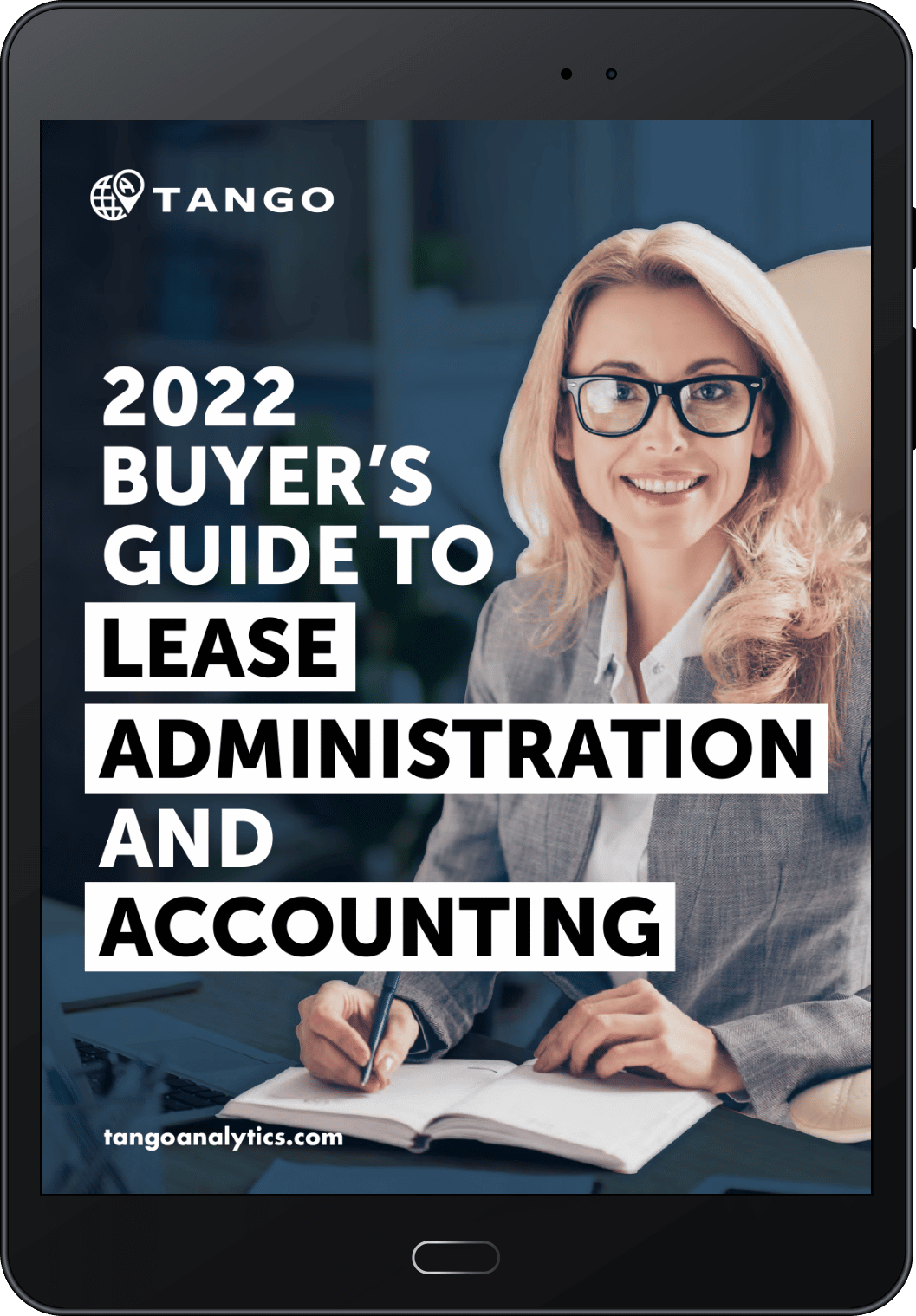
2022 Buyer's Guide to Lease Administration and Accounting
Lease Management Next Steps
Lease management is a constantly growing, changing beast. To keep track of your leases, comply with the most recent lease accounting standards, and make the right decisions for your organization at the right time, it’s important to stay on top of all lease management tasks, and implementing a lease management software is the best way to do it.

With Tango Lease, you get all of your lease-related information organized into intuitive dashboards, equipping administrators and finance professionals to easily manage lease accounting schedules, avoid overcharges, maintain compliance with the latest lease accounting standards, and perform lease activities. With our software your team can analyze and explore your entire lease portfolio from the same place.


